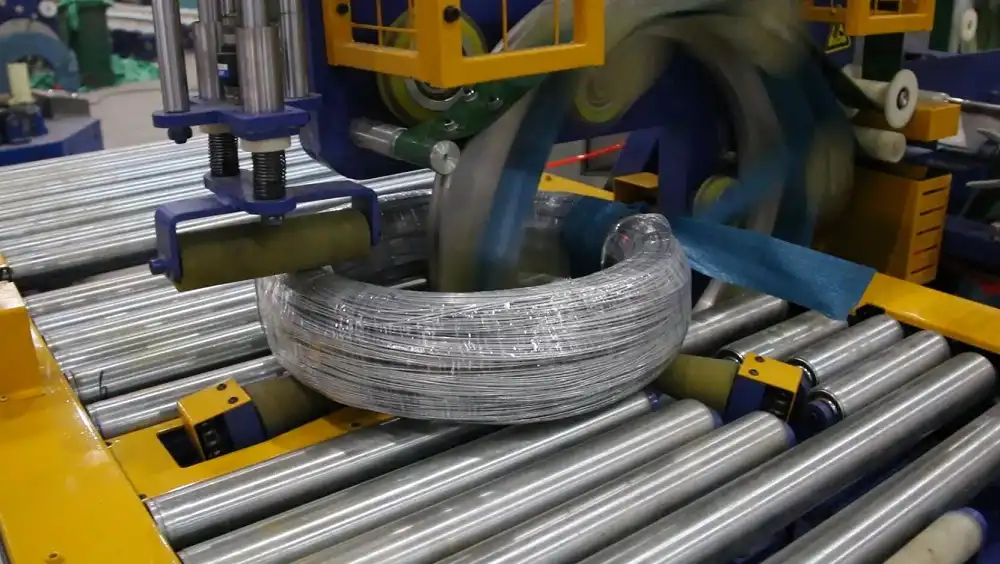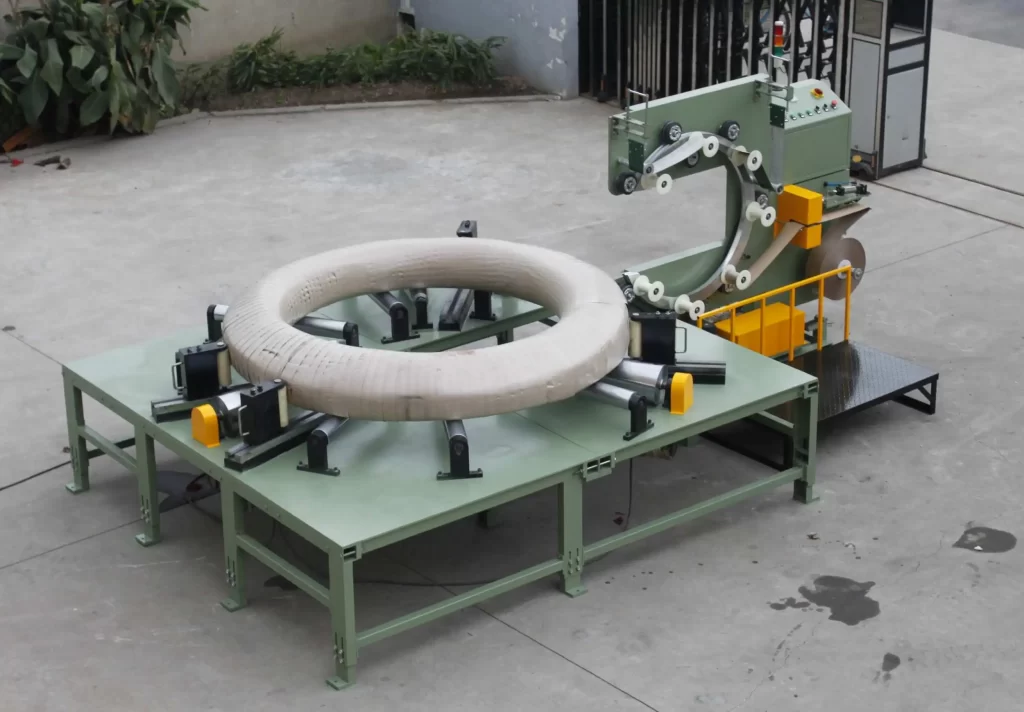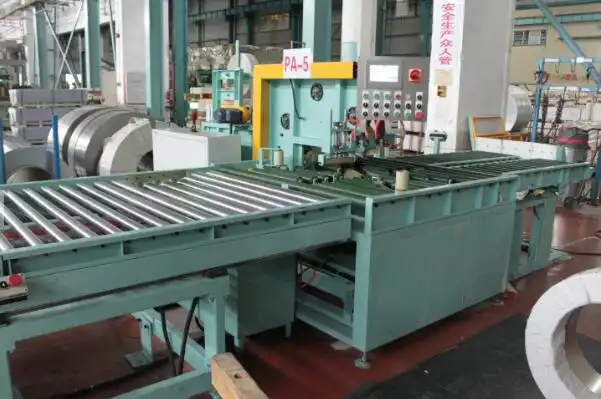# How Can a Coil Wrapping Machine Improve Efficiency on Your Production Line?
In the fast-paced world of manufacturing and logistics, maximizing efficiency isn't just an advantage—it's essential for survival and profitability. For operations involving the handling, storage, and shipment of materials like steel, copper, or wire coils, the **coil wrapping machine** has emerged as a critical asset. These automated systems go beyond simply packaging; they streamline workflows, significantly reduce manual errors, cut down on labor costs, and elevate the quality and consistency of your final product protection. This guide explores how integrating a coil wrapping machine can fundamentally enhance your production line's efficiency.
[featured image: A modern coil wrapping machine seamlessly integrating with an industrial production line.]
From fully automated sequences to unparalleled wrapping precision, a coil wrapping machine represents a strategic investment in operational excellence. Businesses adopting this technology consistently report benefits such as faster turnaround times, reduced consumption of packaging materials, and notable improvements in workplace safety.
But how specifically does this equipment deliver such significant efficiency gains? Let's delve into the technical capabilities and tangible benefits these machines offer.
***
### Table of Content
1. Why is Efficiency Paramount in Modern Production Lines?
2. What Key Features of Coil Wrapping Machines Drive Efficiency?
3. How Does Automation in Coil Wrapping Reduce Costs and Errors?
4. Can Advanced Wrapping Technology Future-Proof Your Operations?
***
## 1. Why is Efficiency Paramount in Modern Production Lines?
### 1.1 The Impact of Inefficiencies on Productivity
Inefficiencies within a production line—whether from manual process variations, bottlenecks, or errors—create ripple effects. Delays in packaging can postpone shipments, lead to missed delivery deadlines, and ultimately erode customer trust. Manual handling and wrapping are often significant sources of these bottlenecks.
A **coil wrapping machine** directly tackles these issues by automating and standardizing the wrapping process. Operating at consistent speeds and applying wrapping materials with uniform quality, these machines ensure your production flows smoothly, minimizing disruptions often caused by human variability or fatigue.
### 1.2 The Role of Precision in Quality Control and Protection
Manual wrapping introduces inherent inconsistencies. Uneven tension in the wrapping material, poor alignment, or inadequate overlap can compromise the integrity of the packaging, leaving coils vulnerable to damage from moisture, dust, or impacts during handling and transit.
**Coil wrapping machines** eliminate these variables through precisely calibrated control systems. Features like automated tension control and edge alignment ensure every coil receives consistent, optimal protection, safeguarding product quality from the production line to the end-user.

*Caption: Automated steel wire coil packing machine ensuring consistent wrap quality.*
[featured image: A close-up of a coil wrapping machine applying even tension and wrapping material with perfect alignment.]
This precision directly boosts efficiency. By maintaining high packaging standards consistently, you reduce the need for costly rework, minimize product damage claims, and enhance your reputation for reliability.
### 1.3 Meeting the Demands of High-Volume Production
Modern manufacturing environments frequently operate at high volumes, requiring hundreds or thousands of coils to be packaged daily. Manual wrapping methods struggle to keep pace with such demands without significant labor investment and potential quality compromises.
**Coil wrapping machines**, designed for high throughput, efficiently handle large production volumes. Their speed ensures that packaging does not become a bottleneck, allowing your operation to meet tight schedules and high customer demand effectively.
***
## 2. What Key Features of Coil Wrapping Machines Drive Efficiency?
### 2.1 Automated Tension Control and Wrapping Precision
A core efficiency-driving feature is **automated tension control**. This ensures the wrapping material (like stretch film or VCI paper) is applied with optimal, consistent force across the entire coil. This prevents wraps that are too loose (offering poor protection) or too tight (potentially damaging the coil or wasting material).
Furthermore, automated systems guarantee precise material placement and overlap, ensuring complete coverage and minimizing material consumption while maximizing protection.

*Caption: Pre-strand wire wrapping machine showcasing automated precision.*
### 2.2 High-Speed Operation for Faster Turnaround
Designed for speed, **coil wrapping machines** can significantly reduce the time required to package each coil compared to manual methods. Many models offer adjustable wrapping speeds, allowing customization based on specific product requirements and production flow rates.
[featured image: A high-speed coil wrapping machine wrapping multiple coils in sequence on an automated production line.]
This increased speed directly translates to higher throughput and faster overall turnaround times, enabling quicker order fulfillment and improved responsiveness to market demands.
### 2.3 Integration with Production Line Automation
Modern coil wrapping machines are engineered for seamless integration into broader automated production lines. Capabilities often include:
* **Conveyor Integration:** Automatic feeding and discharging of coils.
* **Automated Loading/Unloading:** Robotic or mechanical systems for coil handling.
* **Sensor-Based Operation:** Smart detection for initiating wrap cycles and ensuring safety.
* **PLC Control Systems:** Integration with central line management software.
This integration minimizes manual intervention between production stages, reducing transfer times and potential handling errors, thereby creating a more cohesive and efficient workflow. Learn more about optimizing manufacturing workflows through automation [here](https://www.apqc.org/resource-library/resource-listing/optimizing-manufacturing-workflows-automation-best-practices) (link to a relevant authoritative source like APQC or similar).
***
## 3. How Does Automation in Coil Wrapping Reduce Costs and Errors?
### 3.1 Lowering Labor Costs Through Automation
Manual coil wrapping is inherently labor-intensive. It requires dedicated personnel for a repetitive and physically demanding task. Automating this process with a **coil wrapping machine** allows staff to be redeployed to higher-value activities, such as quality control or machine supervision.
While there is an initial investment, the reduction in direct labor costs associated with manual wrapping typically leads to a rapid return on investment (ROI) and sustained long-term savings.
### 3.2 Reducing Material Waste
Manual wrapping often results in inconsistent material usage – sometimes too much, sometimes too little. **Coil wrapping machines** utilize precise controls and programmable wrap patterns to apply the optimal amount of packaging material consistently for each coil type and size.
Features like pre-stretch mechanisms in stretch film wrappers can significantly reduce film consumption (often by 50% or more) compared to manual application, leading to substantial savings on material costs and contributing to sustainability goals.

*Caption: Copper coil wrapping machine demonstrating efficient material application.*
[featured image: A coil wrapping machine using stretch film efficiently, with minimal waste visible on the production line.]
Over time, these material savings compound, significantly lowering operational expenditures.
### 3.3 Minimizing Errors and Improving Consistency
Human error is a common source of inefficiency and quality issues in manual processes. Inconsistent wrap tension, missed spots, or improper securing can lead to damaged products and customer complaints.
**Automated coil wrapping** eliminates this variability. The machine executes the programmed wrap cycle identically every time, ensuring each coil is packaged to the same high standard. This consistency reduces the likelihood of packaging failures, minimizes the need for rework or repackaging, and enhances overall product integrity upon arrival.
***
## 4. Can Advanced Wrapping Technology Future-Proof Your Operations?
### 4.1 Adapting to Evolving Production Demands
Market conditions and production requirements change. Advanced **coil wrapping machines** are often designed with scalability and flexibility in mind. Modular designs, programmable logic controllers (PLCs) allowing for easy parameter adjustments (e.g., coil size, wrap patterns), and the ability to handle different wrapping materials enable businesses to adapt quickly.
Investing in a machine with such adaptability ensures your packaging operation can evolve alongside your production needs without requiring costly equipment replacement.
### 4.2 Enhanced Features for Specialized Applications
The latest generation of coil wrappers includes features catering to specific industry needs:
* **VCI Paper/Film Application:** For corrosion protection during long-term storage or sea freight.
* **Edge Protection:** Automated application of corner boards or protectors.
* **Top Sheet Applicators:** Added protection against dust and moisture.
* **Weighing and Labeling Integration:** Combining packaging with logistics data capture.
[featured image: A coil wrapping machine applying moisture-resistant wrapping for coils destined for long-term outdoor storage.]
These specialized capabilities allow businesses to meet stringent customer requirements or challenging environmental conditions efficiently, enhancing competitiveness.
### 4.3 Integration with Industry 4.0 Technologies
Leading **coil wrapping machines** are increasingly incorporating Industry 4.0 principles:
* **IoT Connectivity:** Enabling remote monitoring of machine status, performance metrics, and diagnostics.
* **Data Analytics:** Providing insights into throughput, material usage, and potential bottlenecks.
* **Predictive Maintenance:** Using sensor data to anticipate potential failures and schedule maintenance proactively, minimizing downtime.
* **Integration with MES/ERP Systems:** Seamless data flow between the packaging station and higher-level planning systems.
Embracing these smart technologies allows for real-time performance optimization, proactive issue resolution, and data-driven decision-making, significantly boosting long-term operational efficiency and resilience.
***
## Conclusion
**Coil wrapping machines** are far more than just packaging equipment; they are powerful catalysts for enhancing production line efficiency. By automating demanding tasks, optimizing material use, minimizing human error, and ensuring consistent, high-quality product protection, these machines deliver substantial operational and financial benefits. Their ability to integrate with automated lines, adapt to changing needs, and leverage smart technologies positions them as a crucial investment for modern manufacturing and logistics operations.
[claim: Investing in a coil wrapping machine tailored to your production needs is more than a cost-saving decision—it’s a strategic step toward achieving long-term efficiency, scalability, and a stronger competitive position in the market.]
By carefully selecting a coil wrapping machine that aligns with your specific operational requirements and leveraging its advanced capabilities, you can significantly optimize your production workflow, improve product quality, meet customer expectations more effectively, and build a more efficient, future-ready operation.